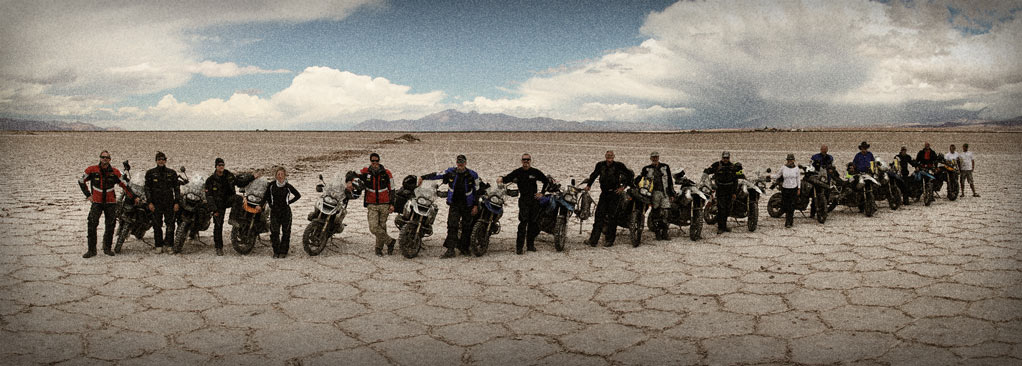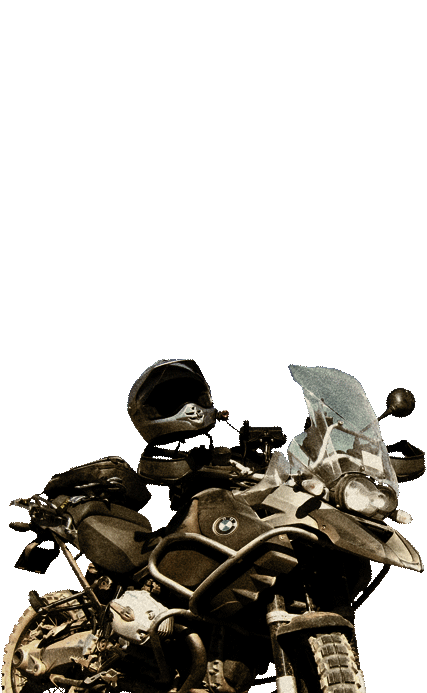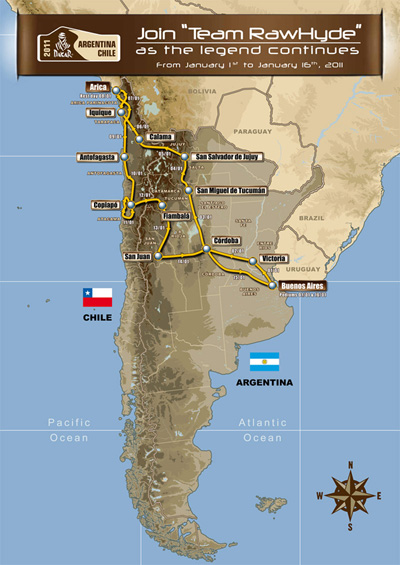RawHyde's Dakar Rally Tour 2011 Blogs
Below are the Blogs sent from the 2011's Dakar Rally; sent to RawHyde's subcription list at random intervals by Jim Hyde. Enjoy!
Preparing For Adventure - 12/30/10
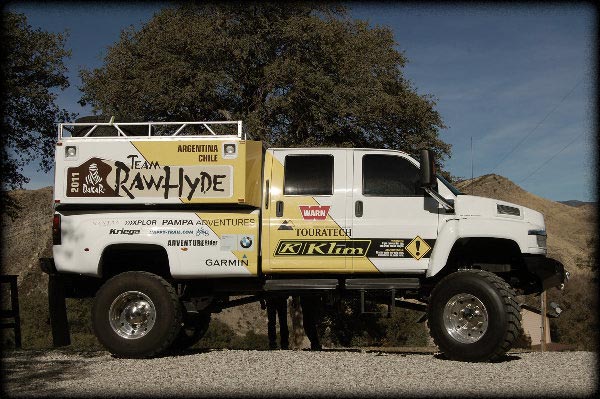 To all of our adventure-oriented friends - The Dakar rally - eagerly awaited by the world; and especially by 20 anxious RawHyde Adventurers is nearly at hand. Over the next two and a half weeks we'll be updating you all as much as we can from Argentina and Chile as we follow the worlds greatest motorsports event. What "Mt. Everest" is to mountain climbers... The Dakar is to motorsports enthusiasts. its simply the "Ultimate" thing to do... We are thrilled to be here and we hope you'll enjoy coming along for the ride.
To all of our adventure-oriented friends - The Dakar rally - eagerly awaited by the world; and especially by 20 anxious RawHyde Adventurers is nearly at hand. Over the next two and a half weeks we'll be updating you all as much as we can from Argentina and Chile as we follow the worlds greatest motorsports event. What "Mt. Everest" is to mountain climbers... The Dakar is to motorsports enthusiasts. its simply the "Ultimate" thing to do... We are thrilled to be here and we hope you'll enjoy coming along for the ride.
Five members of Team RawHyde are now in Argentina and more are arriving daily. The RawHyde "Advance crew" has been in country for the last 3 days and have been involved in staggering amounts of paperwork and bureaucracy and delays and B.S.
As many of you know we have shipped our own support truck from California to Buenos Aires - and the process of doing so has been a collosal pain in the butt. We learned today that although the truck has arrived in the Buenos Aires area, It's still in the ship... and the ship is anchored in the Rio Platte (two miles away) and won't be brought to the pier for another three or four days. It's a frustrating delay but certainly not the end of the world.
We have spent the last two days working with the freight forwarder, customs broker, shipping line, and other bureaucrats to try and get our truck off the boat. We are learning that the word "Adventure" can have many definitions, and one of them is dealing with Customs agents in a foreign country. Anyway more on that later.
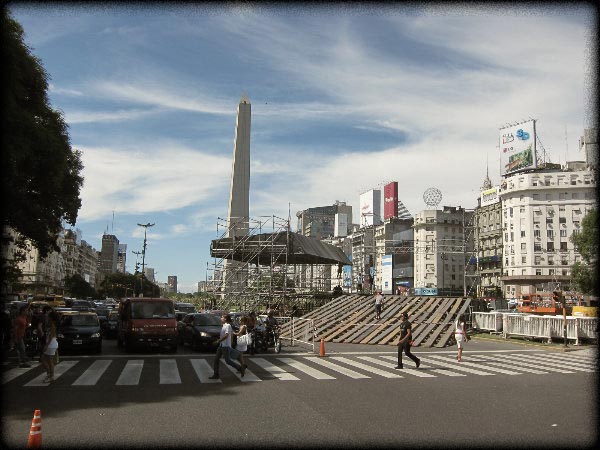 In the few idle hours that have been available to us we've prowled the streets of Buenos Aires checking out the preparations for Dakar which are happening all over town. The picture to the right shows the construction of the starting podium over which all of the competitors will ride on the morning of January 1st. More on the pomp and circumstance later as well.
In the few idle hours that have been available to us we've prowled the streets of Buenos Aires checking out the preparations for Dakar which are happening all over town. The picture to the right shows the construction of the starting podium over which all of the competitors will ride on the morning of January 1st. More on the pomp and circumstance later as well.
Now for a quick change of topic - The title of this post is "preparing for adventure" and the crew has been talking among themselves about how our packing lists have changed in just the last few years. It used to be that leaving on an "adventure" required precious little. We would bring clothes, maps, guide book, camera & film. That was about all we used to need. Now it seems that our electronics outweigh all the rest of our gear combined. One member of our party (a man and wife) admit that between them they have 27 pounds of clothing and 32 pounds of electronics.
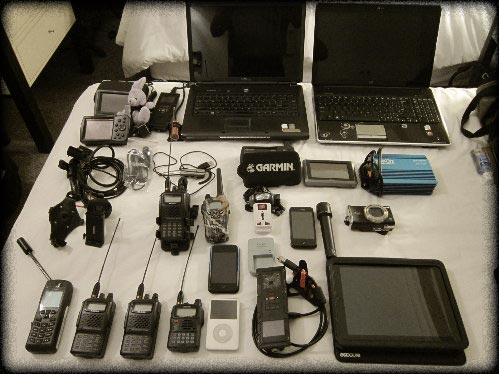 The photo to the left shows the collection electronics that just one other member of the crew (Kevan) and I have brought with us. Computers, GPS units, Short Wave radios, video cameras, ipods, ipads, iphones etc. etc. - not to mention all the chargers for these devices. Funny how things we didn't even know about a few years ago are now indispensable parts of our adventures. One note... we have radios for some of our crew in this photo. OK - You'll hear from us soon...
The photo to the left shows the collection electronics that just one other member of the crew (Kevan) and I have brought with us. Computers, GPS units, Short Wave radios, video cameras, ipods, ipads, iphones etc. etc. - not to mention all the chargers for these devices. Funny how things we didn't even know about a few years ago are now indispensable parts of our adventures. One note... we have radios for some of our crew in this photo. OK - You'll hear from us soon...
Till then Happy New Year.
~Jim Hyde
Dakar Update... New Years... and Jan 1 - 01/01/10
Hi everyone- Thank you for the kind remarks about our first Dakar update for the 2011 edition of the Dakar. I'm glad to be able to share our story.
The main challenge with posts like this is that we are hardly ever "current"... sometimes because we can't get an internet connection at night (which was the case last niight) ... sometimes after a 12 hour travel day I just can't collect my thoughts well enough to want to send them... so this is "day old news" but still... it gives you some perspective on what you may see at home.
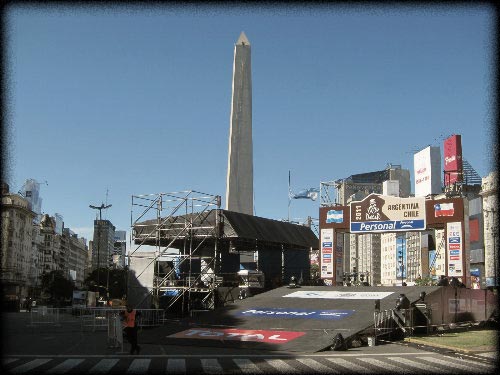 SO - from yesterday things are finally getting moving here in what the locals call BA (Buenos Aires) - on the afternoon of New Year's Eve we wandered down to Avenue Nuevo de Julio to take a look at the final Dakar preparations. My first e-mail showed the podium under construction and now you can see what it looks like in its official form on the eve of the Dakar.
SO - from yesterday things are finally getting moving here in what the locals call BA (Buenos Aires) - on the afternoon of New Year's Eve we wandered down to Avenue Nuevo de Julio to take a look at the final Dakar preparations. My first e-mail showed the podium under construction and now you can see what it looks like in its official form on the eve of the Dakar.
It was actually kind of eerie because on the afternoon of New Year's Eve there wasn't anyone about and we were basically alone at the launch point for the Dakar and that was a really neat experience. So after we got the obligatory photo of the podium we headed over to the Parc Ferme.
|
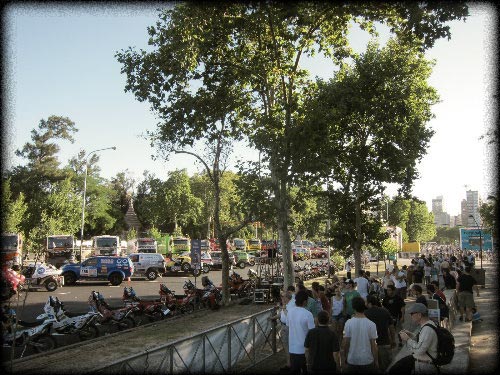 The Parc Ferme is basically a quarantined area for the vehicles.They've had their technical inspection and are on visible display just before the race- but you can't get to em. I was hoping to bring in the new year wandering around and inspecting the millions of dollars worth of hardware that comes to this. So I was a little bit bummed to learn that we would'nt have a chance to actually walk among the cars and trucks, but I understand the fact that once the vehicles of been inspected they really don't want strangers running around among their a their high dollar race vehicles. We were kept at a distance but nonetheless it was amazing to see hundreds of motorcycles, hundreds of the big trucks and the oddest collection of four wheeled cars buggies and homemade racers that you've ever seen. A couple of the pictures below illustrate what it looked like.
The Parc Ferme is basically a quarantined area for the vehicles.They've had their technical inspection and are on visible display just before the race- but you can't get to em. I was hoping to bring in the new year wandering around and inspecting the millions of dollars worth of hardware that comes to this. So I was a little bit bummed to learn that we would'nt have a chance to actually walk among the cars and trucks, but I understand the fact that once the vehicles of been inspected they really don't want strangers running around among their a their high dollar race vehicles. We were kept at a distance but nonetheless it was amazing to see hundreds of motorcycles, hundreds of the big trucks and the oddest collection of four wheeled cars buggies and homemade racers that you've ever seen. A couple of the pictures below illustrate what it looked like.
So Parc Ferme closed at 7 PM giving us just enough time to move over into one of when this BA's upcoming districts called Palermo, I think it would be fair to say that Palermo is to Buenos Aires what the French Quarter is to New Orleans Mardi Gras and it was absolutely nuts.
We found an amazing restaurant called Latitude 58 and we settled down for the evening. A few minutes before midnight our waiter brought us some party favors some masks and some noisemakers and promptly at the stroke of midnight all hell broke loose. The firecrackers they have in Buenos Aires make the M 80s that we occasionally hear in California look like sound like "kiddy toys". There were deep concussive explosions that echoed through the alleys. I flinched every time one went off. On top of the fireworks there was dancing in the streets as the picture that I've enclosed shows and the most amazing part was a Brazilian drum band that drove the street dancing into a frenzy. It was very cool.
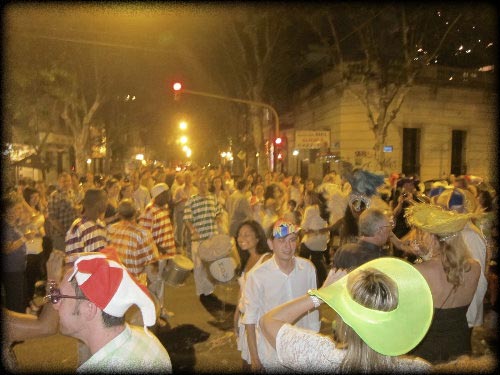 The particularly unique thing is that this was the most orderly "street party" I have ever seen. No one was "out of control"... how unusual...
The particularly unique thing is that this was the most orderly "street party" I have ever seen. No one was "out of control"... how unusual...
So after five days in country the Dakar is on the move it's January 1 the race began today at 2 PM and we're on our way to Córdoba to meet up with the rest of our group and and get ready to rub elbows with the racers for the next 13 days.
Well thats all for now.... stay tuned as there is more coming soon though there'll probably be a two or three day Before we can get another e-mail out to you. We are going to spend the next two days dealing with customs trying to get our truck out of the port... and that probably wont have too many exciting details to report.
Cheers for now...
~Jim
Argentina's country life and "launch for Team RawHyde." - 01/02/10
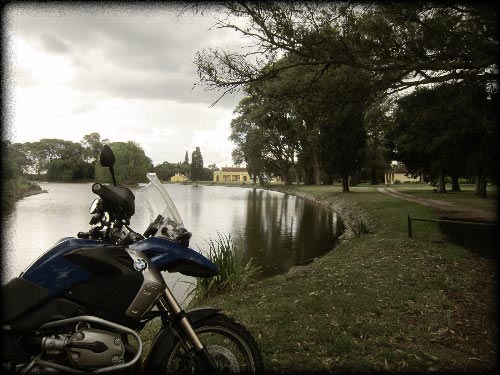
After five days of waiting in Buenos Aires Team RawHyde is just about ready to hit the road. All of the members of our tour arrived in Córdoba, Argentina last night, they had a chance to inspect and personalize their motorcycles (GPS, bar risers and such) which was followed by a wonderful "Parilla" which is the Argentine word for barbecue. The Parilla was hosted at the home of our hosts, and I must say ... the Argentines know a thing or two about meat... It was one of the best "BarBQ's I've ever had. (of course there were liberal amounts of Malbec wine to wash it all down) ... perhaps that had something to do with why it was so good. :-)
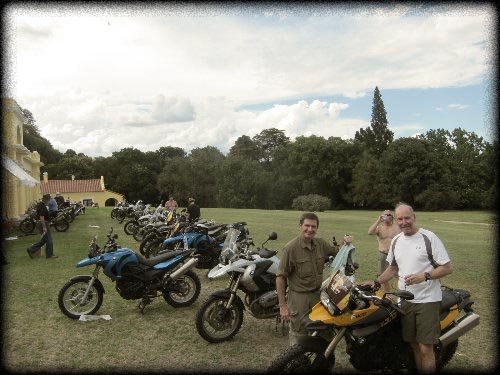 As the days have passed we've learned a great deal more about Argentine culture and our indoctrination deepened last night at our hotel which is a historic ranch named "Estancia La Paz". Estancia La Paz used to be comprised of several hundred thousand acres of productive farmland, vineyards and cattle country but as generations of children of the founding family have grown up and been given parcels of the ranch as their inheritance the overall size of the property has dwindled to a fraction of its original span but nonetheless it's amazing. As a hotel now it is capitalizing on what Argentina's heritage is all about. It has 20 rooms or so in the main building & remodeled carriage houses and outbuildings form other "wings" to the hotel and it is still situated on hundreds of acres of prime land just outside the second largest city in Argentina which is Córdoba. Argentina is a genteel country that has its roots deeply embedded in Western European history and Estancia La Paz could easily be a noble man's Villa in the countryside of France.
As the days have passed we've learned a great deal more about Argentine culture and our indoctrination deepened last night at our hotel which is a historic ranch named "Estancia La Paz". Estancia La Paz used to be comprised of several hundred thousand acres of productive farmland, vineyards and cattle country but as generations of children of the founding family have grown up and been given parcels of the ranch as their inheritance the overall size of the property has dwindled to a fraction of its original span but nonetheless it's amazing. As a hotel now it is capitalizing on what Argentina's heritage is all about. It has 20 rooms or so in the main building & remodeled carriage houses and outbuildings form other "wings" to the hotel and it is still situated on hundreds of acres of prime land just outside the second largest city in Argentina which is Córdoba. Argentina is a genteel country that has its roots deeply embedded in Western European history and Estancia La Paz could easily be a noble man's Villa in the countryside of France.
It is here that the team began to drift in from the airport or local hotels in preparation for our tour which began this morning. A couple of other pictures are attached which show the bikes and riders "hanging out"... getting familiar with their bikes and generally enjoying a quiet afternoon in the Argentine countryside.
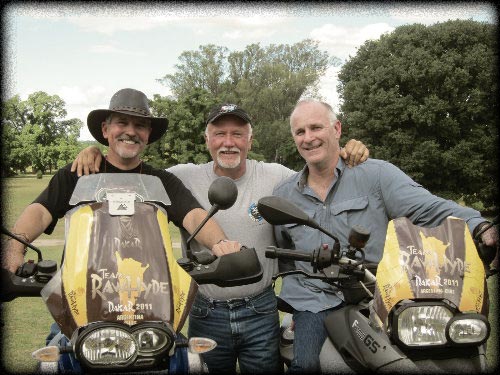 You'll note from the photo (left) that one of the important parts of getting ready for this year's Dakar was putting the windshield graphics on the motorcycles. Here I am with two of my long-time friends Charlie Walton and Randy MacClanahan with our special graphics which we hope will tie us just a little more closely to the whole excitement of Dakar.
You'll note from the photo (left) that one of the important parts of getting ready for this year's Dakar was putting the windshield graphics on the motorcycles. Here I am with two of my long-time friends Charlie Walton and Randy MacClanahan with our special graphics which we hope will tie us just a little more closely to the whole excitement of Dakar.
For myself and two other members of our team today was a little melancholy however, as we had to return to Buenos Aires to continue the saga of retrieving our support truck. Once we have received our truck I'll do an entire e-mail devoted to the trials and tribulations of importing vehicles into countries like Argentina when you have a tight timeline.
That's all for now folks stay tuned for more in the upcoming days.
All the best,
~
Jim Hyde
Dakar Day 5 - Calama to Iquique, Chile,
Iquique is home to the largest sand dune in the world (over 3/4 mile high) - and it's a pretty well known fact that the Dakar guys like to play in the sand. All I can say is WOW! Yesterday we arrived in Iquique about 5 PM just as the bulk of the racers were arriving in town...and the tallest sand in the world set the stage for one of the most dramatic wrap ups to any of the Dakar days so far.
Imagine this if you will.... Just think of yourself as a racer... (yea I know... its a fantasy - but just imagine. ) You have driven over 700 km today and you are almost done...You are just a mile or so from the bivouac (home for the nite) which represents a shower, a meal, and some sleep. You come to the edge of this giant sand dune... your last obstacle for the day. You ease your vehicle over towards the edge, you can see the bivouac below ... just past the base of the dune. The only problem is you have to go straight down the face of this dune to get there and its fricking "vertical". So whats the big deal?? Well... due the nature of the sand and the steepness its impossible to stop on your way down... its also very difficult to make "course corrections" unless you are under power.... If you back off the gas to "steer" theres a good likelihood of "rolling" the vehicle. ( I have a crazy sequence of photos showing a vehicle "tumbling" down the face of a dune... its best to make course corrections under power...because under power your "steering wheels" are lifting up on the sand... during the braking process the "steering wheels" are ploughing... thats why there's risk of a rollowver - Anyway....
What's a guy to do? Take a deep breath make sure your vehicles going straight and hit the gas. This represents the ultimate commitment, because as I said... once your vehicle gets in motion you cannot stop. So here you go... full throttle... straight down... no chance to stop. Now... the crazy part... there are people... lots of people... crossing the course, hanging out... squeezing the line you have to follow... and you are a cannonball of horsepower, carbon fibre and steel.... crazy...
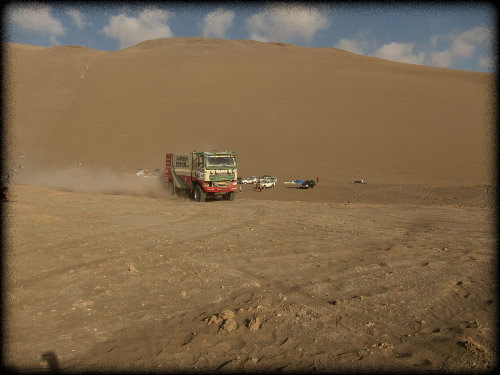 Over the two-hour period that we had to watch the race we saw everything from bikes to quads sand buggies and the big trucks hurtling full throttle straight down the face of this. It was awesome. Robby Gordon of NASCAR fame was clearly the highlight of the afternoon. His bright pink Hummer running roughly 1000 hp came hurtling down the dune so fast that he cleared nearly a 100 feet of air in a jump near the base of the dune... the crowd went wild.
Over the two-hour period that we had to watch the race we saw everything from bikes to quads sand buggies and the big trucks hurtling full throttle straight down the face of this. It was awesome. Robby Gordon of NASCAR fame was clearly the highlight of the afternoon. His bright pink Hummer running roughly 1000 hp came hurtling down the dune so fast that he cleared nearly a 100 feet of air in a jump near the base of the dune... the crowd went wild.
The picture to the right shows one of the big racetrucks and if you look behind it you'll see two more cars are buggies coming down the face of the dune. In a day or so I hope to have a you tube video loaded that shows Robby Gordon's pass. He was a real crowd pleaser and is absolutely one of the favorite drivers in the race.
All the best,
~
Jim Hyde
Dakar Day 6 - Iquique to Arica - The Start
Today was the sixth day of the race and Team RawHyde and is starting to get a little tired. We camped last night on the beach in a Iquique, because the Dakar had taken every hotel room in town. Due to the fatigue levels we decided to make it a short day and drive the 8 km out of town just to watch the start of the race and then get back to our hotel in time for a shower a nap and an early dinner.
It was an interesting process watching the the race begin for the day. The first hundred or so racers departed in order of their overall ranking. Typically a motorcycles begin the race followed by the Volkswagen Tauregs, and the big Russian Kamaz trucks. All the vehicles are in a queue, and are released for the day at the same time intervals as they arrived the prior afternoon. This launch format seems to apply primarily to the competitive vehicles. The noncompetitive vehicles are launched at roughly 30 second intervals in a much more relaxed manner.
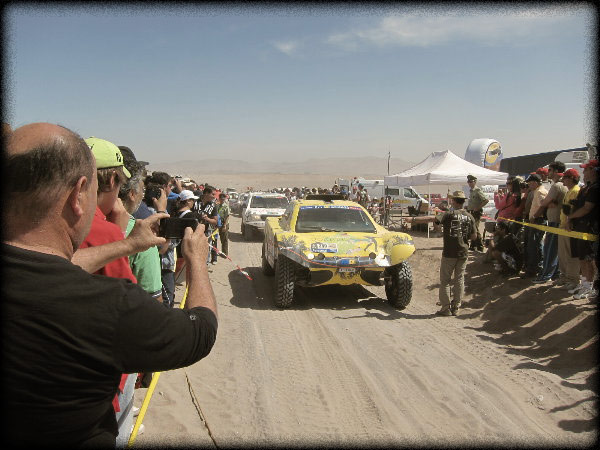 Heres a photo showing the process of starting. You'll note there is a guy in a brown shirt to the right side of the car... his arm is horizontal and he is holding 2 fingers out... that means that in 2 seconds the driver will hit the gas. This guy is the official starter. He has a stop watch on a clip board in front of him... and he is releasing the driver in accordance with the time of his arrival the prior day.
Heres a photo showing the process of starting. You'll note there is a guy in a brown shirt to the right side of the car... his arm is horizontal and he is holding 2 fingers out... that means that in 2 seconds the driver will hit the gas. This guy is the official starter. He has a stop watch on a clip board in front of him... and he is releasing the driver in accordance with the time of his arrival the prior day.
The process works like this... the car arrives at the checkpoint and gets a stamp on their timesheet. then they "que" up in order.
When they arrive at the starters station they may have a wait of a minute or two... then the starter holds a "fist" up in front of the windshield to get their attention. He then opened his hand showing five fingers and begins a 5 second countdown closing one finger per second. He then drops his arm and jumps out of the way as the driver slams his foot down on the throttle. It's really quite dramatic and a lot of fun to watch the process. Some of the cars like Robby Gordon's Hummer spray a shower of rocks and sand onto the cars and bystanders behind him and in spite of the pelting everybody loves it.
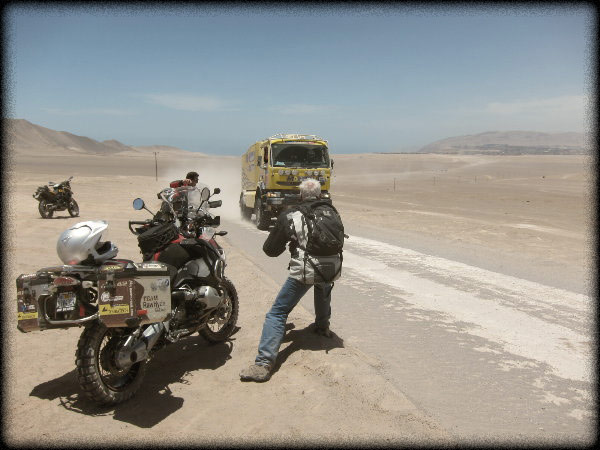 Getting out on the race course. One of the coolest aspects of the Dakar is that it except for the control zones you can stand right at the edge of the course anywhere along the hundreds of miles of the route. It's nothing that could ever happen in the US due to the liability and the risks of some idiot allowing himself to get hit. Myself and five members of our crew moved way out into the backcountry and chose an area where the vehicles were coming by fairly slowly so we could get some good photos. I think the picture below gives you an idea of just how close you can get to the action. Yeah I know some of you might think that I'm the idiot getting so near but it's really really cool to see the action up so close. (besides... we chose a safe location... really )
Getting out on the race course. One of the coolest aspects of the Dakar is that it except for the control zones you can stand right at the edge of the course anywhere along the hundreds of miles of the route. It's nothing that could ever happen in the US due to the liability and the risks of some idiot allowing himself to get hit. Myself and five members of our crew moved way out into the backcountry and chose an area where the vehicles were coming by fairly slowly so we could get some good photos. I think the picture below gives you an idea of just how close you can get to the action. Yeah I know some of you might think that I'm the idiot getting so near but it's really really cool to see the action up so close. (besides... we chose a safe location... really )
All the best for now... we'll get a couple more updates out to you in the next day or so.
Cheers
~
Jim Hyde
Hello everyone, I promised a catch-up e-mail explaining why there has been such a lapse in our communications about the race. - 01/08/11
The promoter of the Dakar rally has an interesting phrase for what it means to participate in this event. "An extreme challenge for those who go and dream for those who stay behind" - I could not agree more - it's challenging to be here as a tourist let alone as a competitor. From the very beginning of our time in Argentina we have had a series of the challenges to deal with. Truly... its part of the game, but it can be frustrating to say the least.
Shipping delays - we've learned one thing for sure and that is there are no certainties with ocean freight. When we initially booked transport for our truck and some of our motorcycles we were assured by the shipping line that everything would be in the port of Buenos Aires by 21 December. (two full weeks prior to our need for them) This deadline was predicated on our truck and bikes being in Galveston, Texas to be loaded on the ship the second week of November.
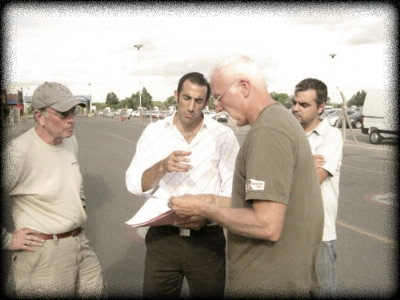 So wouldn't you know it; Just one day after the truck went on the ship the schedule began to slip. A week later the ship was scheduled to arrive on Christmas Eve in Buenos Aires, and according to the schedule at that time we would receive our equipment on December 27. A few days later we were notified that the ship would arrive on the 29th, which if everything went smoothly would still be okay because we would get the truck on the morning of January 2 just in time to make the drive to Córdoba which was the meeting point for our group. The schedule didn't change after that point, so we booked our airfare to fly from Los Angeles to Buenos Aires on 26 December. We arrived to find that yes indeed the ship would be arriving in the channel near the port the following morning. What we did not know at that time was that the port was severely congested and we later found out we wouldn't get access to any of our gear until January 4.
So wouldn't you know it; Just one day after the truck went on the ship the schedule began to slip. A week later the ship was scheduled to arrive on Christmas Eve in Buenos Aires, and according to the schedule at that time we would receive our equipment on December 27. A few days later we were notified that the ship would arrive on the 29th, which if everything went smoothly would still be okay because we would get the truck on the morning of January 2 just in time to make the drive to Córdoba which was the meeting point for our group. The schedule didn't change after that point, so we booked our airfare to fly from Los Angeles to Buenos Aires on 26 December. We arrived to find that yes indeed the ship would be arriving in the channel near the port the following morning. What we did not know at that time was that the port was severely congested and we later found out we wouldn't get access to any of our gear until January 4.
This latest news put us in a real bind, obviously we needed to be in Córdoba to meet our group and get the tour started, so we hired a driver and a van and headed to Estancia La Paz to meet the group. As you all know from a prior e-mail that I sent we had a very special evening and a lot of fun and it was a great way to kick off the tour. The only problem was that three of us needed to return immediately to Buenos Aires to get our truck and motorcycles as they were due to clear customs the following morning. So - with only a couple of hours of sleep we got up at 5 AM crawled into the van and slept while our driver returned us to BA.
New Friends - I've learned one thing now for sure about the process of dealing with customs and foriegn countries. You need friends and connections ! We now have two new friends in the port... and our amazing customs broker in BA. The three pictures attached are of Federico, Pablo, and Graciela. Each played a vital role in making the best of a tough situation. Here's how it worked.
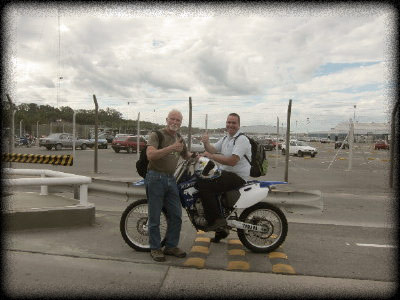 Federico is our customs broker - in the picture above he is standing next to me on the left. Next to him on the left is my good friend Emmet Horgan whose motorcycle was also stuck on the ship. And this is one of the many moments where we had to discuss options about the bureaucracy we were facing. Anyway - about Federico, he was amazing and tackled the unbelievable pile of paperwork that comes with the importation of expensive equipment. He worked with us daily for a week taking several anxiety laden phone calls per day from me and other members of the crew, then then he spent the entire day on January fourth walking us from office to office driving to and from the port then to customs back to the port and so on and so forth. Thank you Federico
Federico is our customs broker - in the picture above he is standing next to me on the left. Next to him on the left is my good friend Emmet Horgan whose motorcycle was also stuck on the ship. And this is one of the many moments where we had to discuss options about the bureaucracy we were facing. Anyway - about Federico, he was amazing and tackled the unbelievable pile of paperwork that comes with the importation of expensive equipment. He worked with us daily for a week taking several anxiety laden phone calls per day from me and other members of the crew, then then he spent the entire day on January fourth walking us from office to office driving to and from the port then to customs back to the port and so on and so forth. Thank you Federico
Pablo is a senior staff guy at the port. Pablo is a real gem. When we first arrived at the port (on Jan. 4th) we were told that there was no possible way that our truck would be unloaded from the ship on that day. And then came Pablo - it turns out he's a motorcycle rider and owns a Yamaha YZ 426 and he also spoke perfect english (his mom is an english teacher) . He's also pretty far up the hierarchy of port management. We showed him a picture of our truck and explained that we were there for the Dakar and were now two days late because of port congestion. That was all he needed to hear - he said give me two hours. And then he pulled some magic- our truck was off the boat and in secure storage in a little over an hour and a half. It turns out that due to all of the phone calls that Federico had been making to customs and that I had been making to the shipping company the entire port knew about our truck - but Pablo is really our hero. He made it happen. Here is a picture of him and I just after he told me we were ready to roll. As a thank you - I have invited him to California to take part in one of our desert rides... lets see if he can make it.
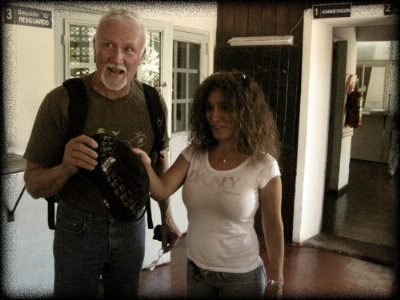 Graciela is the administrative person that we worked with. When we first showed up at customs she gave us that irritated look that overworked admin types usually give the latest face that shows up with a problem that needs to be solved. But she quickly brightened when she saw my BMW GS hat. In fact she made it pretty clear that she wanted that cap... I said - "well its pretty stinky.... I have been wearing it for a week... and she said... no problem I can wash it... At that point I realized that an opportunity was presenting itself -
Graciela is the administrative person that we worked with. When we first showed up at customs she gave us that irritated look that overworked admin types usually give the latest face that shows up with a problem that needs to be solved. But she quickly brightened when she saw my BMW GS hat. In fact she made it pretty clear that she wanted that cap... I said - "well its pretty stinky.... I have been wearing it for a week... and she said... no problem I can wash it... At that point I realized that an opportunity was presenting itself -
So I said... heres the deal - You can have this hat - - When I get the paperwork for my truck ! ! ! that was all the motivation she needed. She became a whirling dervish of energy and focus. She walked our paperwork around to the desks of the people that needed to sign various things... and secured all the necessary documents for us... and we were out of customs in a little over an hour. Who'd a thunk it... the power of a BMW baseball cap. The picture to the left shows "Gracie" taking possesion of her new cap.
Long days - once we finally got our truck the longest day began; we left Buenos Aires about 5 PM on January 4 and drove 36 hours straight stopping only for fuel and some light snacks and arrived at three o'clock in the morning Jan. 6th in Calama, Chile. A drive of a little over 1500 miles in a day and a half. Oddly enough when we pulled into the hotel most of our party was still awake since they had only arrived only an hour before us. It turns out that at the border crossing which I'll describe below it had been nearly a five hour process to get the group through.
The border crossing from hell. What happens when 600 race teams and several thousand followers, mechanics, crewmembers, and tourists try to pass through a sleepy border crossing on the top of the Andes? You get the border crossing from hell. We didn't know it but as we were approaching the border in our truck the last of our riders had just taken off for the hundred mile ride back down the western side of the Andes to Calama. They had spent nearly 5 frustrating hours, standing in line answering questions, and going through the machinations of border transit. It's never easy on an average day but with the chaos of the Dakar everybody's nerves were frazzled, they were tired, and cold ( it was nearly freezing on top of the Andes at 15,000 feet- even in the middle of summer. ) In spite of "coca leaves" - Oxygen deprivation was also adding to the difficulties of dealing with the cold and the stress of the crossing. However it all worked out OK in the end everybody made it to the hotel had a very, very late dinner and while they probably won't admit it just yet - the hardship of the evening and the crossing bonded them together as a group in a way that no other experience can.
The bottom line? It's been a heck of a trip so far, - and in spite of all the chaos - its awesome to have the chance to participate again in the Dakar. Its just an amazing spectacle and we'll now have the chance to keep you more up to date... the upcoming days are shorter and we are in hotels with Wi-Fi each night. Stay tuned.
Today is a "rest day" and tomorrow the race continues... I'll be able to get the next report out tomorrow nite from Antofagasta, Chile after the racers have completed the longest stage of the entire race. At the moment from our hotel in the Iquique, we are almost halfway to Antofagasta saw planned for tomorrow morning is to get up early and ride out into the desert to a checkpoint where we'll be able to see the first and the fastest of all of the competitors come by. Those of you who read these reports last year may remember something we called the money shots. This was where we were able to ride side-by-side with the competitors and get some good photos were to try it again this year and tomorrow's the day.
One last fun thing... there is a free "App" for the Dakar... it shows up to the minute You Tube videos and all sorts of daily info for your iphone and ipad. Its free at the apps store.
All the best to everyone from Iquique, Chile.
~ Jim Hyde
Dakar Update - coming to you from Antofagastqa, Chile. - 01/10/11
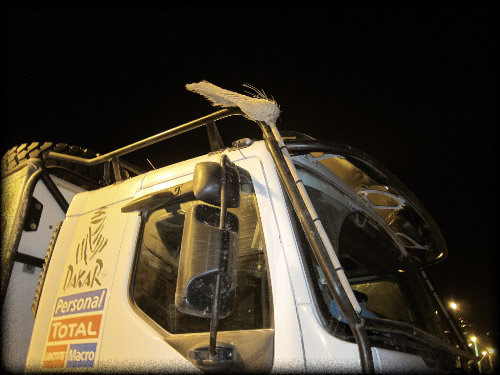 You know the funny thing about a race is that the attention of the world is only focused on "who is in front" or how is my favorite rider doing? Etc.
You know the funny thing about a race is that the attention of the world is only focused on "who is in front" or how is my favorite rider doing? Etc.
Ever wonder who is absolutely dead last in a race like the Dakar? I titled this e-mail the "unsung heroes" because at the very back of the pack doing a job that has absolutely no glamour is the "sweep truck" or trucks in this case. (there are 4 of them)
"Sweep" is a term that seems to be unanimously used in any country and any language. It literally means to sweep up the residual stuff that's left behind during the race. Whether it's the burned-out hulk of an ATV, or simply a vehicle that's broken down and cannot be repaired the sweep truck gets it. Please note in the picture to the left the "brooms" tied to the roll bar of the truck. (there is one on both sides of the cab.) this denotes "sweep".
The way the process usually works is that the truck is notified by the Dakar headquarters in France that is a disabled vehicle on the course.
Why does the order come from France? Simply due to the fact that that's where communication headquarters is. In spite of the fact that the race is in South America the nerve center is in France. It's actually pretty complicated so but let me give you a scenario - let's say that a motorcycle is out on the course, and has a wreck. The "organization is immediately notified ! How? There is a motion sensitive satellite transponder mounted on the motorcycle, it is installed by the" organization" (i.e. the Dakar rally group) as a safety precaution for all competitors. So in the case of our wreck the motion sensor immediately sends out an emergency signal which is transmitted to France. The French communication director notifies one of the three helicopters that is always in the air over the Dakar. At the same time via a speaker on the motorcycle the headquarters tries to reach the pilot. This is a little confusing to most Americans because we think that pilots are only people who fly aircraft, but on the Dakar everyone driving any form of vehicle is called pilot.
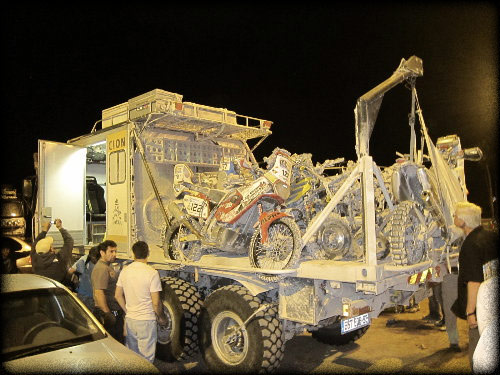 So headquarters tries to reach the motorcycle rider or pilot and let's say in this instance he's okay and he's able to communicate via his radio that his bike is a wreck. The helicopter flies over the area where the accident occurred to get a visual, and then they send the GPS coordinates to a sweep truck. The truck proceeds to the scene of the accident picks up the "pilot" the motorcycle and all the pieces that have been knocked off - and then proceeds to the next disabled vehicle.
So headquarters tries to reach the motorcycle rider or pilot and let's say in this instance he's okay and he's able to communicate via his radio that his bike is a wreck. The helicopter flies over the area where the accident occurred to get a visual, and then they send the GPS coordinates to a sweep truck. The truck proceeds to the scene of the accident picks up the "pilot" the motorcycle and all the pieces that have been knocked off - and then proceeds to the next disabled vehicle.
Now here's a bummer, if the sweep truck gets you you are out of the race ! AND - you get to ride in the vomit box! You're probably wondering what's the vomit box?
Well - if you look at the box mounted on the truck just in front of the motorcycles you'll see through the open doorway there is a seat in there. Actually there are eight seats (four facing forward and four facing backwards). These are the seats for the pilots of broken vehicles. There is no suspension in the seats meaning they don't absorb the bumps of bashing around in the back coutry, and there's no window to see out of while you ride. You cannot anticipate the jolts that the truck is going to take, and you just have to hang on and take the ride. It can be a hell of a long ride - 12 hours or so before you get out. There is no better recipe for getting "sea sick" than to be in a closed up box with no view of the outside... Thus the term "vomit box".
As you can see from the picture here the "Sweep truck" had a busy day... 5 broken or wrecked motos, and two quads. One of the quads was burned... and nothing but a bunch of "slag"...
So now you know who the last people are everyday at the Dakar. The sweep truck drivers and the pilots of the broken vehicles!
All the best from Antofagasta Chile
Jim Hyde
Dakar Update - Checkpoint action! - 01/11/11
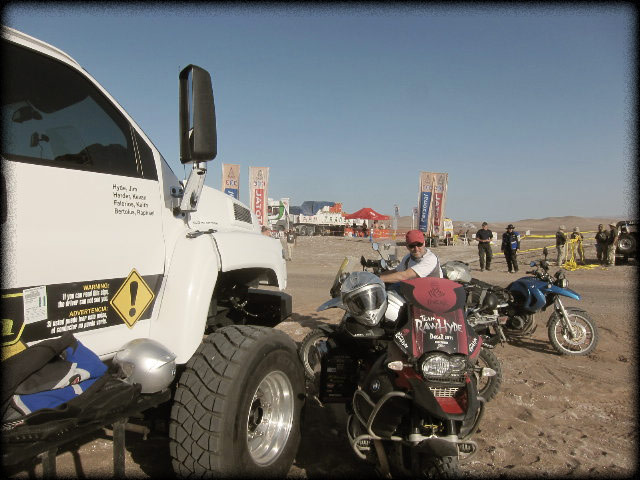 Today we spent the day at a checkpoint in the middle of the desert halfway between Iquique and Antofagasta Chile. We got a very early morning start and arrived at the checkpoint about 30 min. before the very first competitor came through.
Today we spent the day at a checkpoint in the middle of the desert halfway between Iquique and Antofagasta Chile. We got a very early morning start and arrived at the checkpoint about 30 min. before the very first competitor came through.
It's fascinating to see how it is all managed. The motorcycles and the quads have a much different process at the checkpoint than the cars and trucks. This checkpoint was about 350 km from the start and it was a refueling station for the bikes and quads.
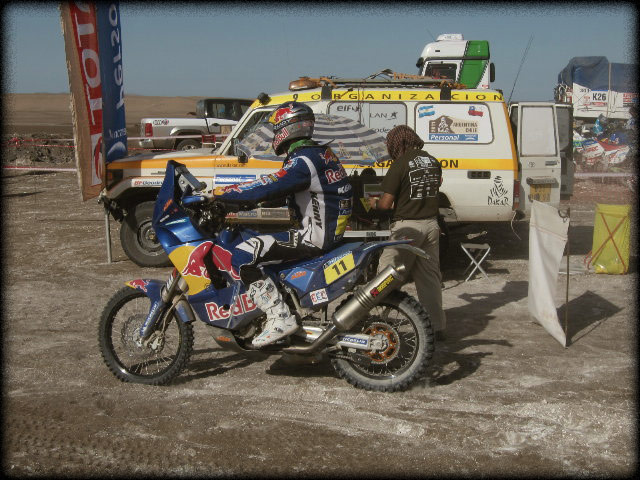 This checkpoint was also a mandatory 15 min. rest period for the pilots of the motorcycles and quads. In the photo to the right you can see the refueling station between the vertical flags. The truck is loaded with 50 gallon drums of fuel, and as the motorcycles approached the checkpoint the attendant grabbed their timeslip's and directed them under the canopy to the refueling point. The cars and trucks were not required to stop, the copilot simply held the time slip out of the window against the side of the car the attendant slapped it with a stamp and the pilots barely had to stop.
This checkpoint was also a mandatory 15 min. rest period for the pilots of the motorcycles and quads. In the photo to the right you can see the refueling station between the vertical flags. The truck is loaded with 50 gallon drums of fuel, and as the motorcycles approached the checkpoint the attendant grabbed their timeslip's and directed them under the canopy to the refueling point. The cars and trucks were not required to stop, the copilot simply held the time slip out of the window against the side of the car the attendant slapped it with a stamp and the pilots barely had to stop.
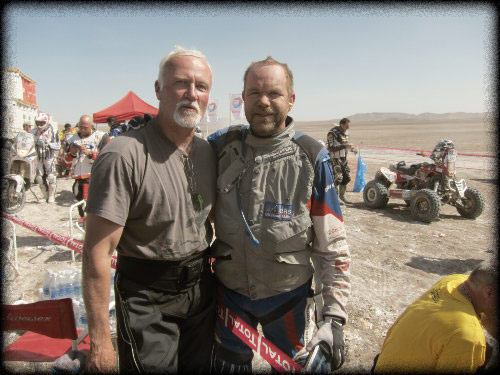 One of the cool things for me was the chance to see my friend Simon Pavey as he passed through. Simon has raced the Dakar six or seven times and those of you who have seen the films the " Long Way Round" or the "Long Way Down" starring Ewan McGregor and Charley Boorman may remember seeing Simon in the films. As it happens Simon is a peer of mine as he is the director of the BMW off road school in Great Britain. He had cameo appearances in both of the aforementioned films as he trained Charlie and Ewan and for their round the world journeys.
One of the cool things for me was the chance to see my friend Simon Pavey as he passed through. Simon has raced the Dakar six or seven times and those of you who have seen the films the " Long Way Round" or the "Long Way Down" starring Ewan McGregor and Charley Boorman may remember seeing Simon in the films. As it happens Simon is a peer of mine as he is the director of the BMW off road school in Great Britain. He had cameo appearances in both of the aforementioned films as he trained Charlie and Ewan and for their round the world journeys.
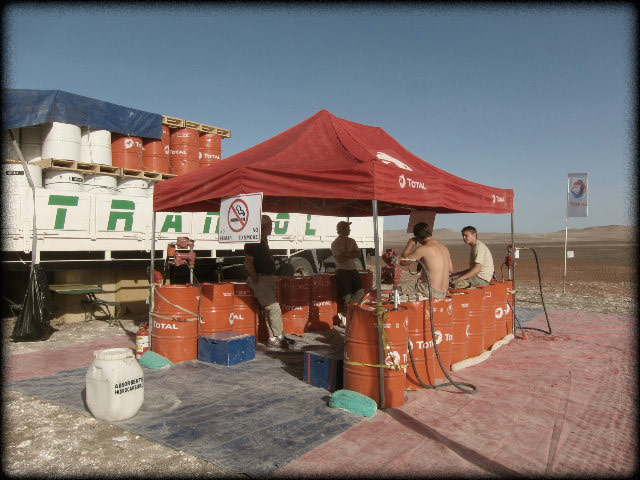 Simon has been to RawHyde. He visited us a couple of years ago for the adventure riders challenge. It was nice to see him, and I was actually in a much better mood than this photo would indicate. I know I look pretty dour - I had been smiling but my expression changed somehow just as the picture was taken.
Simon has been to RawHyde. He visited us a couple of years ago for the adventure riders challenge. It was nice to see him, and I was actually in a much better mood than this photo would indicate. I know I look pretty dour - I had been smiling but my expression changed somehow just as the picture was taken.
I'm going to wrap this up with apologies for the shortness of the message... we have been having some darn long riding days.... and we are all exhausted. Its time for bed....
All the best,
Jim...
Well Folks - The Dakar Ralley is officially over for 2011. - 01/18/11
The Russians won 1st, 2nd, and 3rd place is in the big truck category (my favorite), Volkswagen as usual came in first second and third place with their awesome Tauregs, and Como and Depres won the motorcycle class as they have in the past - my apologies for not being able to send any updates in the last few days.... it's been impossible.
Today I have the time to bring you up to speed on our last couple of days "on the trail" of the Dakar. They were brutal, long and demanding days fraught with challenges - and I was simply unable to get internet access or muster the "will" to get our stories out to you - the days were just too long. To wrap up I have two (maybe 3) more stories to tell... I hope you enjoy.
The last Dakar story was sent to you all just after we spent the day at a checkpoint near Antofagasta, Chile. That was an awesome experience and when we wrapped up our time at that checkpoint and headed for the town of Copiopo our "adventures" continued in earnest. As we headed to the paved road from the final point we been watching the race two of our riders experienced catastrophic failures of their motorcycles.
It's only fair to mention however that the failures were ....shall we say self-inflicted? Perhaps the riders were caught up in the excitement of Dakar - or perhaps they were distracted by continuing action "on the course", but the bottom line is both bikes were rendered inoperable. One rider took a jump off of a small mound of dirt - only to misjudge his landing... and landed squarely on a very hard spot where his wheels straddled the "mound" of hard dirt and his oil pan took the entire shock of landing... Needless to say - the trail of oil gushing from the crankcase lead us back to the scene of the crime... and yes we knew it was "pilot error". Bummer for him - as that meant that the rest of his trip would be "in the truck". Rider number two had a similar problem.... he misjudged the impact his suspension could absorb as he hit a big bump "at speed" and while there was no visible damage from impact.... a trail of oil coming from the side of the motor of his 1200 GS proved to be a cracked engine block.... and rider # 2 was now "in the truck". Yep - the Dakar takes its toll on everyone... tourists as well as competitors. What's the lesson? Well - I guess its "pay attention"  and don't ride beyond the threshold of what the bike (or rider) is capable of enduring. - anyway... such things happen.... (after all less than half of the Dakar Competitors usually finish the race)
and don't ride beyond the threshold of what the bike (or rider) is capable of enduring. - anyway... such things happen.... (after all less than half of the Dakar Competitors usually finish the race)
Our destination for the night after all this excitement was the dusty and gritty town of Copiopo. I like Copiopo, it's the essence of a hardscrabble Chilean Mining town and it's "nested" inside a sea of mountainous sand dunes... perfect for Dakar. Many of you may remember that it was near Copiopo that a drama unfolded last year as a group of miners were trapped deep underground for nearly three months... and were all saved by the heroic efforts of a multinational rescue force. The photo to the right shows the cylinder that was used to bring each trapped miner back to the surface from a half mile underground.
We made a quick run from Antofagasta to Copiopo because we were scheduled for a VIP tour of the famous "Bivouac" which is the moving city that comprises "home base" for the competitors. I think the bivouac is simply awesome... and is always a highlight of the Dakar. Our Argentine partners had arranged a guided tour of the bivouac which gave us some insights we'd have never learned simply walking around.
Here are some fun facts about both race and bivouac that you may find interesting.
- The Dakar Ralley and the "Tour de France" bicycle race are owned and operated by the same company.
- The Dakar has approximately 2500 participants including organization staff and the teams of racers; the Tour de France has 6500 members.
- The Dakar has a full hospital in the bivouac with a staff of 65... including all services found in a regular hospital from X-ray to surgery and a well-stocked pharmacy.
- The Dakar kitchen serves 5000 hot meals a day
- There are 6 helicopters serving the race - three are for "spotting," rally services and evacuation... and three are for media.
- The entire bivouac is "WiFi" so that the teams and competitors can update their followers and family.
- The largest television viewing market for the Dakar is Asia.... go figure.
- The organization prepares half hour television spots for each market in the world. They can prepare a "custom" spot to showcase the progress of any rider or team in just three hours. The media helicopters will follow "favorites" from each country and feed the film directly to the bivouac media center "from the air". Talk about "serious" technology.
- This year there were 450 "teams" from 75 countries... less than half will finish.
And here's what I found particularly interesting. The disparity between the types of teams that are racing is amazing. The difference between the privateers and the professionals is mind boggling. The Dakar is the only "big time" race in the world where a rank novice with no experience can race head to head with seasoned professionals. The organizers also allow for "bare minimalists" to enter along with big bucks teams. Here is an example of how that works.
Take for example our friend Simon Pavey, you remember we met Simon a couple of days ago out on the race course. He is my "counterpart" from the BMW School in Wales and he is also the fellow who trained Ewen McGregor and Charlie Boorman for their trip around the world and the movie "Long Way Around".
Simon is racing as a privateer this year, and his campaign is the ultimate in minimalist Dakar racing. Check it out- the photo you see below shows Simon and all of his support equipment. It's nothing more than a tent, a sleeping bag, and a box. That's all he has - the box contains his clothes, some simple tools, and his camping gear. Each privateer is given one box by the organization, all his stuff has to fit inside that box, and the organization provides the rest of the basic necessities as part of the $35,000 entry fee paid by the rider.
So let's take a look at Simons racing day - He's up at 5 AM for breakfast and a last minute check of his bike... the Race typically started at 6 - 7 AM each day for the bikes. Simon typically puts in a 10 hour day on the course... (sometimes more... sometimes less) At the end of the day Simon comes into the bivouac, sets up his tent, and then begins to work on his bike. He calls it "spannering" - he is his own mechanic...and must do most of his maintenance. The Dakar organizer has two or three mechanics that help the privateers with major tasks... (engine replacement etc.) and they provide one toolbox for all the racers to share. But on a regular day Simon tears his bike apart to clean filters and removes the wheels from his motorcycle and takes them to the tire changing area where an organizers "tire changer" will actually perform the tire change for Simon and give him back two "race ready" wheels for his bike. Simon will normally work on his bike till 9 PM or so... Take time for dinner at the bivouac kitchen - and then he'll return to finish putting his bike back together and hopefully get to bed by 1 AM. During our tour of the bivouac our tour guide said that most of the privateers get about four hours of sleep per night. Imagine doing that 16 days in a row?
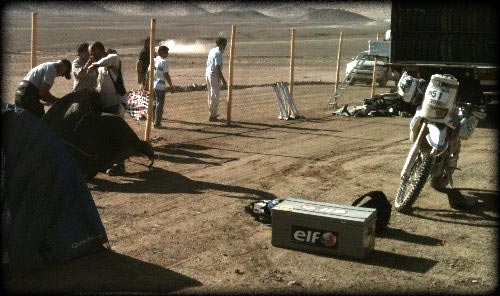 The photo to the right shows me helping Simon put his tent up which is really all that we could legally do. One of our other guys (Kevan) helped Simon a bit tearing his bike down, but was later advised that if he was caught Simon could be disqualified. Needless to say Kevan stopped helping at that point. Anyway... Just imagine living 16 days out of that one metal box?
The photo to the right shows me helping Simon put his tent up which is really all that we could legally do. One of our other guys (Kevan) helped Simon a bit tearing his bike down, but was later advised that if he was caught Simon could be disqualified. Needless to say Kevan stopped helping at that point. Anyway... Just imagine living 16 days out of that one metal box?
Now let's contrast Simons racing efforts to that of team Volkswagen. Obviously as a corporate team Volkswagen has an awful lot of money that they can throw at this and they do.
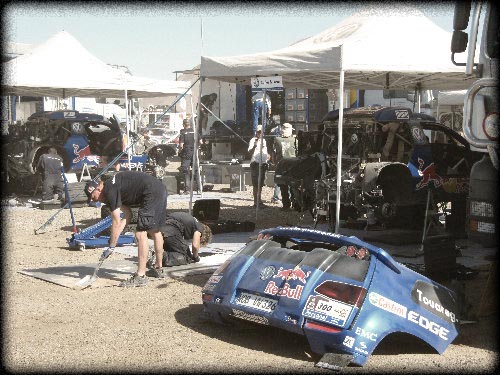 Given the fact that the Volkswagen team has been winning the last few years, the drivers are totally pampered. They don't have to do anything except drive - at the end of their racing day a team of mechanics descend on the cars and tear them completely apart. Each car has its own support truck, and team of mechanics. The driver of each vehicle sits down with the chief mechanic and explains any details that he thinks the mechanics need to know about and he is "off the clock". He then goes for a massage, has dinner and goes to sleep in the air-conditioned bunk of the support truck. Not bad… The picture above is from the Volkswagen "compound" ... this is "Big Bucks racing at Dakar"
Given the fact that the Volkswagen team has been winning the last few years, the drivers are totally pampered. They don't have to do anything except drive - at the end of their racing day a team of mechanics descend on the cars and tear them completely apart. Each car has its own support truck, and team of mechanics. The driver of each vehicle sits down with the chief mechanic and explains any details that he thinks the mechanics need to know about and he is "off the clock". He then goes for a massage, has dinner and goes to sleep in the air-conditioned bunk of the support truck. Not bad… The picture above is from the Volkswagen "compound" ... this is "Big Bucks racing at Dakar"
Well... that's it for the Bivouac... one of my favorite experiences in all the Dakar.
All the best to each of you...
Jim Hyde
Well folks here is one last story from the Dakar 2011. The story of our most rugged, demanding yet most spectacular and amazing day! - 01/20/11
Picking up where we left off - in Copiopo, Chile. The Dakar Race Route made a "loop" out of Copiopo on day 11 and thus the bivouac (and the race ) stayed in the same place for two days which allowed Team RawHyde to have a day of leisure in preparation for our most demanding day of riding - A trip over the Andes on the incredible "Paso de San Francisco". Just imagine this... a rough single lane dirt road, climbing to an altitude of nearly 16,000 feet over the Andes. - now add 20 BMW GS riding tourists and 450 Dakar race teams trying to get over the mountain in the fastest possible time & a chaotic and amazing day is the result.
We made it clear to our group that we wanted them to have an easy day in Copiopo and that we would have an early dinner so that we could get as much sleep as possible for a five AM start over the Andes. Since Paso de San Francisco is nearly 16,000 feet in elevation we knew that altitude sickness would be a real possibility for members of our crew so we tried to take all the precautions we could to avoid getting sick. This included plenty of sleep, proper hydration, and an additional measure in the form of what the native Americans in this area have been using for centuries.
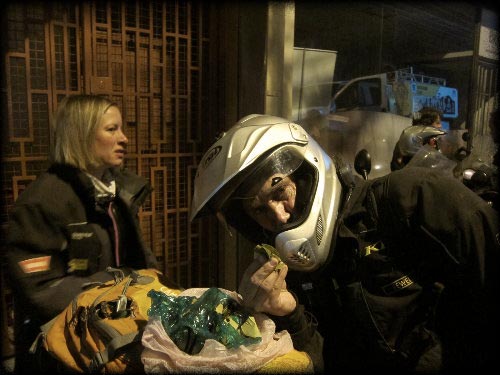 Chewing Coca!
Chewing Coca!
It's well known that chewing coca leaves will typically stave off altitude sickness. So at 5 AM our guide wandered amongst us with a big bag of coca leaves and advised us all to take a big "wad". The picture to the right shows the coca leaves in the green plastic, and the rider in the helmet (face hidden to prevent recognition - grin) is holding up the leaves to show the camera.
I have to say... I am not a big fan of the taste of coca leaves... but they do seem to work for me. I have never gotten altitude sickness down here. Coca leaves are also pretty non-descript. about the size of a quarter stretched oblong - nothing special. So the idea is to take a good sized handfull... chew them into a gooey ball (like a cow) ... and then put them between your cheek and gum... and let the juice form... and swallow it.
It's really got a nasty taste... but in about 15 minutes you begin to feel the effect. Its nothing like drinking an alchoholic beverage... its very sublte... you just relax a bit... a phrase that many of our riders used was "kinda loopy"... Yea I know that doesn't sound very good... riding a motorcycle at 16,000 feet feeling "loopy"... but nonetheless... it works "most of the time"...
I say "most of the time because" for three members of our group this year it just didn't help. Altitude sickness hit three of them pretty hard. One of the three was a "passenger" on her husbands bike, and was so ill she felt as though she couldn't hold on any longer - The next rider had similar issues... too sick to continue riding and the third rider began to feel faint... stopped his bike... and passed out. As you can imagine this slowed down our progress and really drove home the point that riding at altitude can have its "downside". Due to the extremely rough nature of the pass our own support truck was "way behind" the motorcycles... and we wanted to get our sick riders to a more comfortable place as fast as possible so we flagged down a couple of passing support vehicles for Team Volkswagen and The BMW team "Speedbrain". In both instances the drivers of those vehicles were awesome. They had space in their vehicles and took our riders immediately and headed for the border. Thank You Team Volkswagen.... Thanks Team BMW Speedbrain! This "camaraderie between the official teams of the Dakar and us as tourists was an awesome example of people sharing an epic adventure. The official teams looked as us not as a nuisance, but rather comrades in the adventure. Its a very cool thing. We spent a lot of time chatting with the racers at checkpoints, border crossings etc and they are typically thrilled to know that we are following their efforts. I find them far more "approachable" than any other competitor in any other event I have been to. The Dakar is truly an "bucket list" adventure... and we are all sharing the experience.... the racers, us as tourists and the thousands of spectators lining the roadways. Its really good stuff!!!
The top of Paso de San Francisco is nothing short of spectacular. In spite is the difficulties that three of our group faced with the altitude the rest of the group was treated to one of natures most spectacular scenes... 6000 feet above the vegetation line... Paso de San Francisco has a lunar landscape quality. The picture 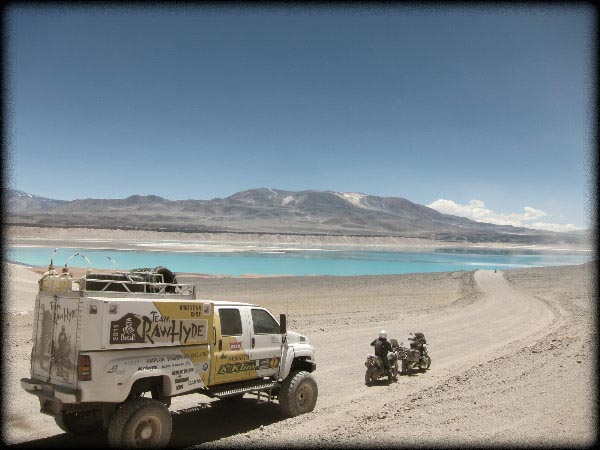 to the right shows a lake that has a crazy chemical blue color that is the result of a minerals that have been leached from the surrounding soils during the rainy season. Its beautiful beyond words. - We had a brief lunch at the side of this lake and carried on as quickly as we could. We know from experiece that the longer you stay above 10,000 feet elevation the more likely the "sickness" will hit you. And once you drop below 10,000 feet you're safe. A follow up note to our three sick riders.... once they were down below 10,000 they all felt much better.
to the right shows a lake that has a crazy chemical blue color that is the result of a minerals that have been leached from the surrounding soils during the rainy season. Its beautiful beyond words. - We had a brief lunch at the side of this lake and carried on as quickly as we could. We know from experiece that the longer you stay above 10,000 feet elevation the more likely the "sickness" will hit you. And once you drop below 10,000 feet you're safe. A follow up note to our three sick riders.... once they were down below 10,000 they all felt much better.
Our next challenge came with our support truck breaking one of the major structureal supports that holds the rear axle in place. The road was brually tough with lots of pot holes and pockets of "fecsh fesch" or silt... Silt pockets are almost as bad as mud... they suck you in... and you cannot get any traction to get started again. It was a tough break.... AND THEN...on top of that we blew an air bag on the back of the truck... and the fenders settled down onto the rear tires... every time we hit a bump the fenders rubbed the tires and we were afraid that they would chew through the tires and cause blow outs... sooooo - we had to finish the trip down off of the mountain at no more that 10 MPH ... ugh... it took several more hours to finally get the truck to the Argentine border.
SO - what did all these challenges and delays cause for the group?.. well - it became clear that we'd be unable to make it to our intended destination that night... so we started looking for alternative lodging. Unfortunately the nearest town (fiambala) had no available rooms in the single hotel in town... so we went to the tourist center to see what our options were.
And here is where one of the more magical things of our trip occurred. Sometimes on a trip like this "adventure" means something really special (in a good way)
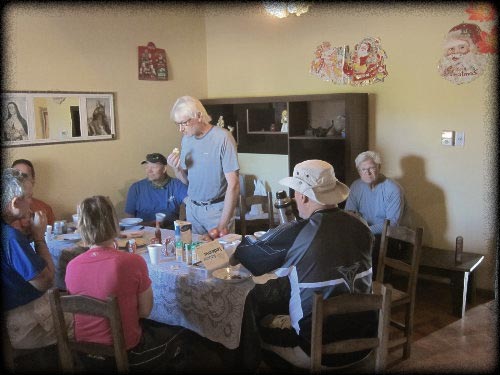 Those of you who read the Dakar stories last year may remember that we stayed in private homes last year in Fiambala, Argentina. We remembered as well and we asked the tourist center if anyone could take a group of 20 Americans into their home for the nite. A couple of phone calls were made... and yes there was a guy who could accommodate us. Five minutes later a young man on a scooter showed up and introduced himself. His name was Luis and he had two houses on the same property that he said could accommodate our group. So myself and our Agentine partner "Nacho" went with him to inspect the houses. They were definitely big enough for us... but were nearly empty of funishings... very spartan... but quite clean... so we said OK.
Those of you who read the Dakar stories last year may remember that we stayed in private homes last year in Fiambala, Argentina. We remembered as well and we asked the tourist center if anyone could take a group of 20 Americans into their home for the nite. A couple of phone calls were made... and yes there was a guy who could accommodate us. Five minutes later a young man on a scooter showed up and introduced himself. His name was Luis and he had two houses on the same property that he said could accommodate our group. So myself and our Agentine partner "Nacho" went with him to inspect the houses. They were definitely big enough for us... but were nearly empty of funishings... very spartan... but quite clean... so we said OK.
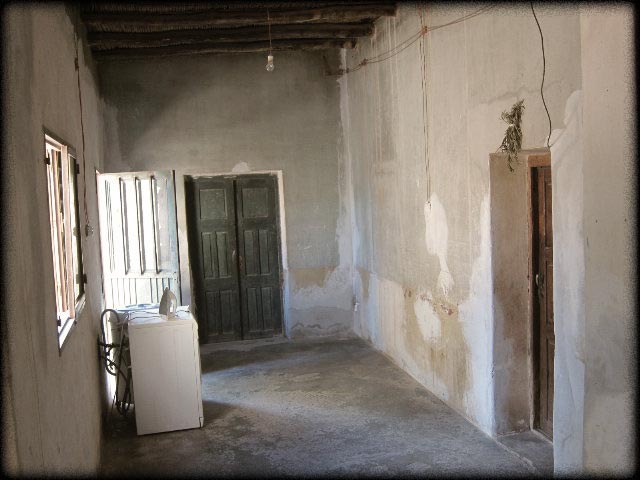 Luis suggested that we should have dinner while he "rounded up" beds from his neighbors to accommodate us. I found out later that Luis only had three beds in his house... one for he and his wife... and one for each of his children. They gave us their beds... and "rented" beds from many of their neighbors so that we all had a comfortable... (or as least "sort of comfortable") bed for the nite.
Luis suggested that we should have dinner while he "rounded up" beds from his neighbors to accommodate us. I found out later that Luis only had three beds in his house... one for he and his wife... and one for each of his children. They gave us their beds... and "rented" beds from many of their neighbors so that we all had a comfortable... (or as least "sort of comfortable") bed for the nite.
Here is how the financial aspect of the transaction worked... (according to Luis)... We paid him $10 bucks per person to sleep in his house... he in turn "rented beds" from his neighbors for $5 bucks each... thus sharing the money a little among the neighbors... and giving us a place to sleep. It turns out that Luis is a "plasterer"... earning about $10 bucks a day... so having 20 gringos in his house for one night netted him nearly 3 weeks pay... He was grateful... and so were we after a very long day on the trail. Luis and his wife and kids were fascinated with us and our motorcycles and spent a lot of time asking questions - and hanging out with us. Then when it was time for bed Luis and his wife and kids retired to one room of the house to give us as much privacy as they could. Our 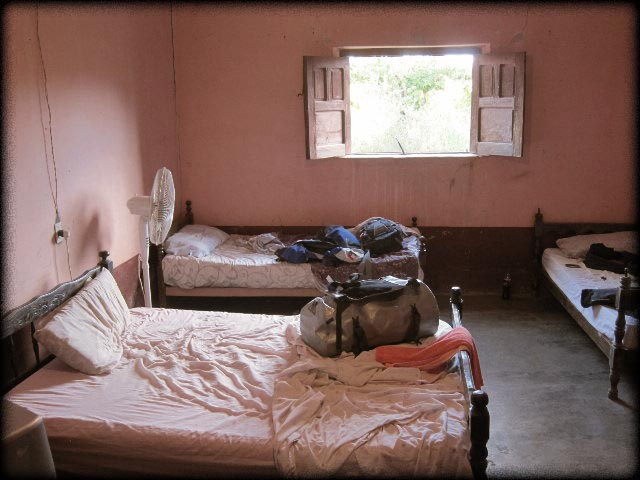 guides made breakfast the next morning in the family kitchen... using their pots and pans & dishes etc. and we had an awesome chance to peek inside the life of an argentine "working class" family. One thing of interest is that it was only a few days after christmas... and the families Christmas decorations were still on display. Note the difference in their Christmas "atmosphere" in their house versus the typical US way of doing it.
guides made breakfast the next morning in the family kitchen... using their pots and pans & dishes etc. and we had an awesome chance to peek inside the life of an argentine "working class" family. One thing of interest is that it was only a few days after christmas... and the families Christmas decorations were still on display. Note the difference in their Christmas "atmosphere" in their house versus the typical US way of doing it.
The next bit of magic that happened to us was that there was a capable mechanic in town who could fix our truck... not like workers in the US - when opportunity knocks the folks in these little hardscabble towns are will to "do whats necessary". Our mechanic was roused from his house at 9:30 pm by the tourist bureau... came to the gas station where our truck was waiting.... and in less than two hours had welded our axle back in place, repaired our airbags and made us "roadworthy again".... All for $60 bucks... That was the deal of the century !
And that about "wraps" our Dakar story for 2011.
The last three days of our journey were pretty unremarkable. Except for the thousands upon thousands of adoring people who lined the roads cheering for us... surrounding us at the gas stops, asking for autographs, wanting photos and stickers etc. I'll post a more complete write up on our website in the next week or so to finalize things and to give a few more insights into the trip...
I find it difficult to "wrap up" Dakar 2011! How do I explain what its like to climb Mount Everest to a casual day hiker ? How to explain an "Iron Man" triathalon to a weekend jogger? This is the real deal... its not a watered down "soft" trip for the casual tourist. Its not a trip for "posers" or someone just looking for a good story to tell at a cocktail party. It was tough... it was exhausting, it was fraught with challenges and risk - as an example... riding in the heavy dust of Paso de San Francisco while the big race trucks thundered by was un-nerving for many of our crew.
But.. All in all... it was a hell of an adventure, everyone got home safely AND everyone fully experienced the Dakar ! Yes we had a couple of busted bikes, and many challenges to solve along the way, but what do you expect when you are 6000 miles away from home? - riding 400 hard miles a day and chasing the Dakar. Its a definite challenge.... Its not for everyone.... but its an authentic adventure in a time where many folks choose to insulate themselves from such things.
If this sort of thing interests you? You can join us for next years edition. We have been told formally by the Dakar organizers that the race will occur in South America again next year and we will be doing the trip again. If you'd like to be considered for Dakar 2012 please let me know... we will only be taking 12 riders next year and we'll begin taking applications in just a couple of weeks.
If you'd like tp get on the list please send me a note.... Otherwise I hope that you have enjoyed the stories - and if you would like to see more keep an eye on our web site as we'll be posting some YouTube videos and more complete stories on the Dakar page of our site.
All the best from Buenos Aires, Argentina
- Jim Hyde
